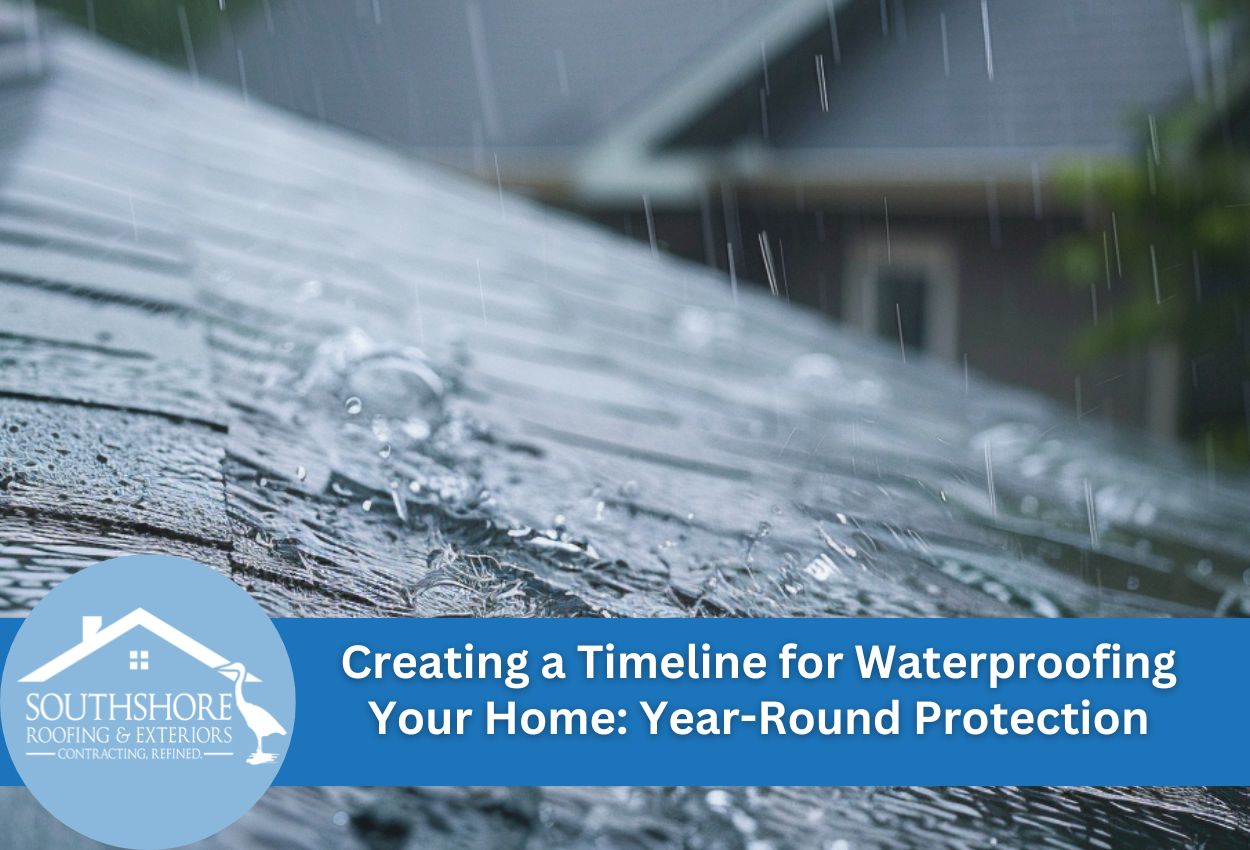Florida’s unique climate can make it difficult for Tampa homeowners to protect their properties from water damage. With heavy seasonal rains, hurricane threats, and high humidity levels year-round, having a strategic timeline for waterproofing your home isn’t just convenient — it’s essential to prevent major damage down the line.
Proper timing of waterproofing projects can mean the difference between a secure, dry home and thousands of dollars in water damage restoration. Many Tampa residents make the mistake of waiting until water issues appear before taking action, but most professional roofers and waterproofing experts recommend a proactive, seasonal approach to home protection.
Understanding when to schedule exterior waterproofing, how long roof waterproofing projects typically take, and the optimal times to prepare before Tampa’s rainy season hits can dramatically improve your home’s resilience against moisture intrusion. The best time to waterproof house exteriors often depends on weather patterns and your home’s roof, siding, and trim materials, with certain projects requiring specific temperature and humidity conditions for optimal results.
A comprehensive seasonal home waterproofing schedule allows homeowners to address different areas throughout the year, ensuring complete protection against Florida’s challenging weather conditions. This approach to home maintenance pays off in both preserved property value and peace of mind.
Pre-Rainy Season Preparations: When to Start Waterproofing
Tampa’s rainy season typically runs from June through September, with the heaviest rainfall occurring between July and August. To ensure your home is fully protected before the first major downpours, waterproofing projects should begin a few months in advance, ideally by March. This timeline isn’t random — professional roof waterproofing projects require adequate curing time, and scheduling early helps avoid the pre-season rush when contractors are completely booked.
The best time to waterproof house exteriors in Tampa is during the dry winter and early spring months when humidity levels are lower and temperatures are moderate. These conditions allow sealants and waterproofing materials to properly adhere and cure, creating more effective barriers against moisture intrusion.
Start with a comprehensive assessment of your home’s vulnerable areas. Focus first on your roof, checking for missing or damaged shingles, compromised flashing around chimneys and vents, and signs of previous leaks in attic spaces. Next, examine exterior walls for cracks, deteriorated caulking around windows and doors, and signs of water staining.
Prioritize your seasonal home waterproofing schedule based on urgency and local weather forecasts. Roof waterproofing project timelines typically range from one to three days for basic treatments to up to two weeks for more extensive work, so planning ahead ensures you’re not racing against approaching storm systems when protecting your Tampa home.
Seasonal Waterproofing Schedule for Florida Homes
Maintaining a consistent waterproofing schedule is important for Tampa homeowners. A quarterly waterproofing calendar helps you stay ahead of potential water damage throughout the year. Winter is ideal for comprehensive roof inspections and repairs when cooler, drier conditions allow for optimal sealant application and curing. During spring, focus on exterior wall waterproofing and foundation assessments before humidity levels rise.
Summer brings Tampa’s rainy season, making it the time for gutter maintenance, downspout inspections, and ensuring water flows away from your home’s foundation. Fall is perfect for post-hurricane season assessments and repairing any storm damage before winter arrives. Hurricane season preparations require additional measures beyond standard waterproofing. Tampa homeowners should install or check storm shutters, reinforce garage doors, and ensure roof straps and clips are secure.
Professional roofers often recommend applying specialized wind-resistant sealants to roofing materials before hurricane season begins. Additionally, installing secondary water barriers beneath roofing materials provides extra protection during intense storms. Following this seasonal home waterproofing schedule ensures your Tampa property remains protected year-round. Remember that the best time to waterproof varies by project type, with most exterior waterproofing taking between two to five days, depending on home size and weather conditions.
Roof Waterproofing Project Duration and Planning
Understanding the timeline for waterproofing your home is essential for Tampa homeowners planning roof protection projects. A typical roof waterproofing project timeline varies based on roof size, complexity, and the specific waterproofing system being installed. For standard residential roofs in Tampa, basic waterproofing treatments may take as little as one to three days, while comprehensive systems for larger homes can extend to five to seven working days. Flat roofs, common in modern Tampa homes, typically require three to four days for proper waterproofing application.
The best time to waterproof house exterior elements like roofs is during Tampa’s dry season between October and April, allowing materials to cure before the heavy summer rains arrive. Weather conditions significantly impact your seasonal home waterproofing schedule. Professional contractors typically require 48 to 72 hours of dry weather both before and after application for optimal results. Material availability can also affect how long home waterproofing takes, with specialty products sometimes requiring ordering lead times of up to two weeks. When scheduling waterproofing before the rainy season, allow for potential delays by starting projects at least 30 to 45 days before Tampa’s typical June rain onset.
Unexpected structural issues discovered during the waterproofing process, such as hidden water damage or deteriorated decking, can extend project timelines by days while repairs are completed. Planning for these contingencies ensures your waterproofing provides lasting protection.
Foundation and Exterior Wall Waterproofing Timeline
Protecting your Tampa home’s foundation and exterior walls requires careful planning and precise timing. A comprehensive waterproofing project for these critical structural elements typically spans two to six days, depending on your property’s size and condition. Starting with a thorough inspection, professionals identify vulnerable areas where water intrusion is likely during Florida’s intense rainy periods.
The foundation waterproofing process begins with excavation around the perimeter, which takes around a day for an average Tampa home. After excavation, crews clean and prepare surfaces and apply primer (one day), install waterproofing membrane (one day), add drainage systems (one to two days), and finally backfill and landscape restoration (one to two days). Proper curing between these stages is essential for effective protection.
For exterior walls, the timeline includes cleaning and surface preparation (one day), crack repair, sealing, and waterproof coating application (one to two days), and curing time (two to three days). The best time to schedule these projects is during Tampa’s drier months (November to April) when consistent temperatures and lower humidity levels allow for optimal adhesion and curing of waterproofing materials.
To maximize efficiency, coordinate foundation and exterior wall waterproofing simultaneously when possible. Many Tampa homeowners combine these projects with other waterproofing work, scheduling foundation treatments immediately after siding waterproofing to ensure complete home protection before the heaviest rainfall. This creates a comprehensive moisture barrier that protects your home from Florida’s challenging weather.
Window, Door, and Entry Point Waterproofing
Entry points are among the most vulnerable areas for water intrusion in Tampa homes. A comprehensive waterproofing timeline for windows, doors, and other entry points typically spans two to four weeks, depending on the number of openings and their condition. Hurricane-resistant solutions require additional planning and often specialized materials that may extend this timeline by a few weeks.
Begin by assessing all entry points during the dry season, looking for deteriorated caulking, warped frames, and failing weather stripping. This assessment phase should be scheduled at least 8 to 10 weeks before Tampa’s rainy season begins. For basic waterproofing repairs, allocate one or two days per window or door to remove old sealants, repair any damaged framing, and apply new weather-resistant caulking.
Hurricane-resistant modifications require more extensive work. Installing impact-resistant windows typically takes at least two days per five windows, while hurricane door installations average around a day per door. These upgrades provide superior waterproofing while meeting Tampa’s hurricane building codes.
Quick projects homeowners can complete in a weekend include replacing weather stripping, resealing exterior door thresholds, and applying new caulking around window perimeters. More extensive projects requiring professional assistance include flashing repairs around windows, door frame replacements, and installing water diversion systems above entry points, which typically require at least two days, depending on complexity.
Maintaining Your Waterproofing Efforts: Timeline for Ongoing Protection
Even the best waterproofing solutions require regular maintenance to continue providing optimal protection for your Tampa home. Establishing a year-round inspection schedule ensures your waterproofing investments deliver long-lasting value and peace of mind. Professional contractors recommend conducting thorough inspections of your home at least twice a year, with additional checks after major storms or hurricanes that frequently impact the Tampa area.
It is also recommended to schedule professional inspections once a year. This allows you to fix any issues before major damage is done. After severe weather events, perform additional inspections within a few days, looking for damaged flashing, missing shingles, or compromised sealants that could lead to water intrusion.
Foundation and exterior wall waterproofing typically requires refreshing every five to seven years, though this timeline may shorten in Tampa’s humid conditions. Window and door seals should be examined twice yearly and refreshed every few years. Gutter systems need more regular cleaning to prevent water overflow that can compromise your waterproofing systems.
To extend the life of previous waterproofing work, apply protective coatings to roof surfaces every three years and reseal foundation cracks promptly. Regular maintenance not only preserves your home’s waterproofing integrity but also helps identify potential problems before they require expensive repairs, ensuring your Tampa home remains protected year-round.
Ensure Your Tampa Home Stays Dry with SouthShore Roofing & Exteriors
Waterproofing your home is crucial in Tampa’s erratic weather. Don’t wait for the rainy season to start your waterproofing projects. Most professionals recommend scheduling your roof and exterior waterproofing at least three months in advance. This timeline allows their team to thoroughly assess, repair, and seal your home against Florida’s toughest storms.
Whether you’re tackling window, door, or foundation waterproofing, starting early ensures that every layer of defense is optimized. Our expert team at SouthShore Roofing & Exteriors is ready to provide top-tier waterproofing services to protect your home year-round.
Don’t risk water damage that can cost thousands to repair. Call SouthShore Roofing & Exteriors today at (813) 400-3329 to schedule a consultation and make sure your home is secure. Let us help you keep your home dry, no matter the season!




